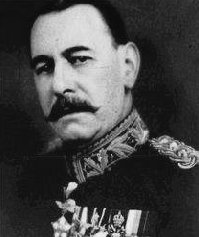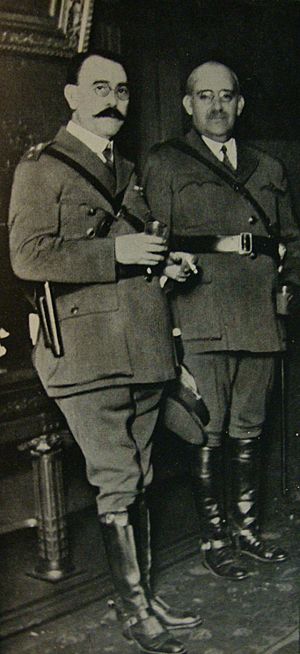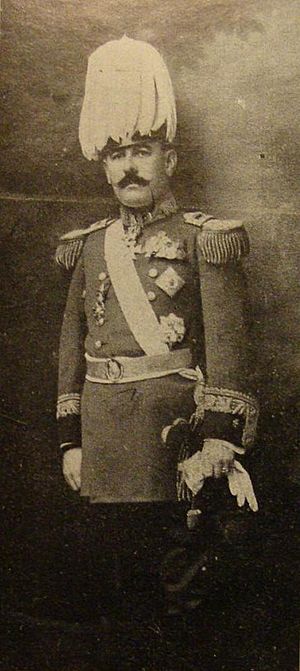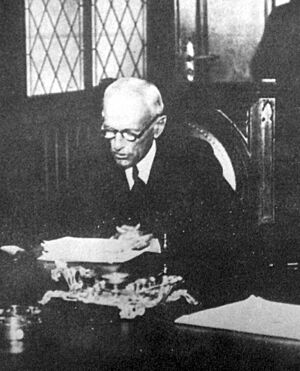José Félix Uriburu facts for kids
Quick facts for kids
José Félix Uriburu
|
|
|---|---|
 |
|
| President of Argentina Appointed by the military junta |
|
| In office 6 September 1930 – 19 February 1932 |
|
| Vice President | Enrique Santamarina (1930) None (1930–1932) |
| Preceded by | Hipólito Yrigoyen |
| Succeeded by | Agustín P. Justo |
| Personal details | |
| Born | 20 July 1868 Salta, Argentina |
| Died | 29 April 1932 (aged 63) Paris, France |
| Political party | Argentine Civic Legion |
| Spouse | Aurelia Madero Buján |
| Profession | Military |
| Military service | |
| Allegiance | Argentina |
| Branch/service | Argentine Army |
| Years of service | 1890–1932 |
| Rank | Lieutenant General |
Lieutenant General José Félix Benito Uriburu y Uriburu (born July 20, 1868 – died April 29, 1932) was an important military leader in Argentina. He became the President of the Provisional Government of Argentina after leading a military takeover. This event, on September 6, 1930, removed President Hipólito Yrigoyen from power.
From September 1930 to February 1932, Uriburu controlled both the government and the law-making parts of Argentina. He was the de facto (meaning "in fact" or "in practice") leader of the country. His takeover was the first in a series of military coups that happened in Argentina over many years.
Uriburu's coup was supported by a group called the Nacionalistas. This was a far-right Argentine nationalist movement. They believed in traditional values and a strong, organized society. After the coup, Uriburu made big changes. He banned political parties and stopped elections. He also suspended the country's 1853 Constitution. Uriburu wanted to reorganize Argentina using ideas similar to corporatism and fascism. These are types of government where different groups (like workers and businesses) are organized by the state, and the government has strong control.
Contents
Early Life and Military Career
José Félix Uriburu was born in Salta, Argentina, on July 20, 1868. His parents were cousins, and he was also the nephew of a former Argentine President, José Evaristo Uriburu. He was also related to Juan Antonio Álvarez de Arenales, a famous general from the wars for independence in South America.
Uriburu began his military training in 1885 at the Colegio Militar de la Nación. In 1890, as a young officer, he was part of the Revolution of the Park. This was a military uprising in Buenos Aires.
In 1894, he married Aurelia Madero Buján. They had four children together. He worked as an assistant to his uncle, President José Uriburu, and later to President Luis Sáenz Peña. In 1905, he helped President Manuel Quintana stop another uprising.
Uriburu became the director of the Superior School of War in 1907. He spent three years in Germany to improve his military training. When he returned, he became the Chief of Staff in Argentina's border regions. In 1913, he went back to Europe as a military expert for Argentina in Germany and the United Kingdom.
After returning to Argentina in 1914, he was elected to the Argentine National Congress. By 1921, he became a Division General. The next year, he was made inspector general of the army. He served on the Supreme Council of War until 1926. At that time, President Yrigoyen made him retire because he had reached the retirement age.
The 1930 Military Coup
Economic Challenges
The Great Depression, a major world economic crisis that started in 1929, hit Argentina hard. The country's economy relied heavily on foreign trade, which made up 80% of its income. The crisis led to lower wages and higher unemployment. This economic trouble created a lot of social tension and helped set the stage for the 1930 military takeover. Many countries in Latin America faced similar problems with their democratic systems during this time.
New Political Ideas
New ideas about nationalism and government were spreading, especially from Italy's leader, Benito Mussolini. He supported a system called corporatism. These ideas caused disagreements within Argentina's People's Party, which eventually broke apart.
Some Catholic nationalists started a newspaper called La Nueva República. This paper was against the government of President Hipólito Yrigoyen. They strongly criticized Yrigoyen's actions, which they felt weakened democracy. This political unrest contributed to the military coup led by General José Félix Uriburu.
The Uprising of September 6, 1930
On September 6, 1930, Uriburu led a military coup that removed President Hipólito Yrigoyen's government. This was the start of a series of military dictatorships in Argentina that lasted until 1983. Uriburu's ideas were based on Catholic neo-corporatist nationalism. He imagined a government with special groups representing unions and businesses, alongside political representatives. These ideas had been growing in Argentina since the 1920s.
This coup was a major event in Argentina's modern history. It marked the first time the military took political power in the country. It also showed the first signs of fascism in the continent. For the first time since the end of Rosas' dictatorship, the Catholic Church became involved in politics, supporting these new ideas.
Uriburu asked the poet Leopoldo Lugones to write the official announcement for the revolution. However, the first version was seen as too extreme by some military leaders, so it had to be changed.
Uriburu's Government
On September 10, 1930, Argentina's Supreme Court recognized Uriburu as the President. This decision created a new legal idea called the De facto government doctrine. This doctrine said that a government that takes power by force could be seen as legitimate if it kept order and security.
Uriburu quickly dissolved the National Congress and declared a state of emergency. He replaced the governors of the provinces with his own choices. He tried to set up a government based on corporatism, similar to the fascist system in Italy. He believed this system would bring peace and order. On September 18, 1930, the ambassadors from the United States and England recognized his new government.
Even though Uriburu said he respected the Constitution, he wanted to bring back a more conservative government. He disliked the Sáenz Peña Law, which had given all men over 18 the right to vote secretly.
Uriburu's government was very strict. It used harsh methods against people who disagreed with him, especially anarchists, communists, and supporters of the previous president. He declared martial law and used strong measures against opponents. He also put many political leaders in prison, including former president Hipólito Yrigoyen. News publications were censored, and universities lost their independence.

The Great Depression continued to affect Argentina's economy. This led to less income for the country, lower spending, and more unemployment. Uriburu's plan for a corporative government, like Mussolini's, did not gain popular support.
In early 1931, Uriburu held elections in the Province of Buenos Aires. However, he canceled the results when the Radical Civic Union (UCR) won. In November of that year, he called for new elections. This time, he banned UCR candidates and organized a system that many people believed was unfair. This period became known as the Infamous Decade in Argentina. Under these conditions, General Agustín P. Justo was elected president.
In March 1931, Uriburu welcomed Edward Windsor, who was then the Prince of Wales (and later King Edward VIII). They visited several places, including the Campo de Mayo military base and the city of Mar del Plata.
Death
After handing over power to Agustín P. Justo, Uriburu left Argentina for health reasons. He died in Paris two months later, in April 1932, after surgery for stomach cancer. His body was later brought back to Argentina and buried at the Recoleta Cemetery.
Removal of Memorials
Over the years, especially during military governments, many statues and memorials were made to honor Uriburu. Streets were also named after him. However, in the 21st century, many of these monuments have been removed, and the streets have been renamed.
For example, in the city of San Carlos de Bolívar, a statue of Uriburu was removed in 2012. In Balcarce, a monument still remains on Avenida Favaloro, which used to be called Avenida Uriburu. In Olavarría, a statue of Uriburu was removed in 2019 after the city council approved it. These actions reflect a changing view of Uriburu's place in history.
See also
 In Spanish: José Félix Uriburu para niños
In Spanish: José Félix Uriburu para niños




